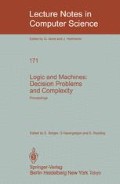Abstract
For an equivalence relation E on the words over some finite alphabet, we consider the following four problems, listed in order of increasing difficulty. Recognition: Decide whether two words are equivalent. Invariant: Calculate a function constant on precisely the equivalence classes. Normal form: Calculate a particular member of an equivalence class, given an arbitrary member. First member: Calculate the first member of an equivalence class, given an arbitrary member. We consider the questions whether p solutions for the easier problems yield NP solutions for the harder ones, or vice versa. We show that affirmative answers to several of these questions are equivalent to natural principles like NP=co-NP, NP ∩co-NP=P, and the shrinking principle for NP sets. We supplement known oracles with enough new ones to show that all the questions considered have negative answers relative to some oracles. In other words, these questions cannot be answered affirmatively by means of relativizable polynomial-time Turing reductions. Finally, we show that the analogous questions with "p" replaced by "Borel" have negative answers.
Preview
Unable to display preview. Download preview PDF.
References
T. Baker, J. Gill, and R. Solovay, Relativizations of the P=?NP question, SIAM J. Computing 4 (1975) 431–442.
A. Blass and Y. Gurevich, Equivalence relations, invariants, and normal forms, SIAM J. Computing, to appear.
E. Hewitt and K. Stromberg, Real and Abstract Analysis, Springer, 1965.
P.G. Hinman, Recursion-Theoretic Hierarchies, Springer, 1978.
T. John, Similarities between NP and analytic sets, preliminary report.
S.C. Kleene, Recursive functionals and quantifiers of finite types, I, Trans. Amer. Math Soc., 91(1959) 1–52.
Y. Moschovakis, Descriptive Set Theory, North-Holland, 1980.
M. Sipser, Borel sets and circuit complexity, extended abstract, 1982.
L.J. Stockmeyer, The polynomial-time hierarchy, Theoret. Comp. Sci., 3(1977) 1–22.
Author information
Authors and Affiliations
Editor information
Rights and permissions
Copyright information
© 1984 Springer-Verlag Berlin Heidelberg
About this paper
Cite this paper
Blass, A., Gurevich, Y. (1984). Equivalence relations, invariants, and normal forms, II. In: Börger, E., Hasenjaeger, G., Rödding, D. (eds) Logic and Machines: Decision Problems and Complexity. LaM 1983. Lecture Notes in Computer Science, vol 171. Springer, Berlin, Heidelberg. https://doi.org/10.1007/3-540-13331-3_31
Download citation
DOI: https://doi.org/10.1007/3-540-13331-3_31
Published:
Publisher Name: Springer, Berlin, Heidelberg
Print ISBN: 978-3-540-13331-5
Online ISBN: 978-3-540-38856-2
eBook Packages: Springer Book Archive

